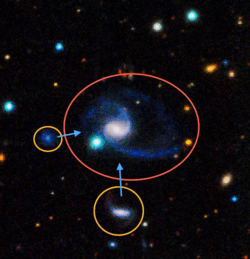GAMA202627
GAMA202627 (also known as G202627) is a barred spiral galaxy similar to our own Milky Way.
-->
 | |
| False-colour image of GAMA202627, with its two close companions highlighted. | |
| Observation data Epoch J2000 | |
|---|---|
| Constellation | Hydra |
| Right ascension | 08h 42m 28.3s |
| Declination | −00° 16′ 18″ |
| Apparent dimension (V) | 0.5 x 0.3 |
| Apparent magnitude (V) | 16.1 |
| Characteristics | |
| Type | SBbc |
| Astrometry | |
| Heliocentric radial velocity | 15355 ± 37 km/s |
| Redshift | 0.051219 ± 0.000123 |
| Galactocentric velocity | 15199 ± 37 km/s |
| Distance | 700 Mly (214.62 Mpc) |
| Other designations | |
PGC 165514 | |
| Database references | |
| SIMBAD | make query
|
| See also: Galaxy, List of galaxies | |
The galaxy was described in a 2012 paper[1] by astronomer Dr Aaron Robotham, jointly from the University of Western Australia node of the International Centre for Radio Astronomy Research (ICRAR) and the University of St Andrews in Scotland, when he searched for groups of galaxies similar to ours in the most detailed map of the local Universe yet, the Galaxy And Mass Assembly survey (GAMA).[2] The Galaxy and Mass Assembly (GAMA) survey is an international collaboration led from ICRAR and the Australian Astronomical Observatory to map our local Universe in closer detail. The galaxy has a redshift measured at z = 0.051219 +/- 0.000123, which corresponds to a distance of 705 Mly, or 216 Mpc.
Dr Robotham noted, "We found about 3% of galaxies similar to the Milky Way have companion galaxies like the Magellanic Clouds, which is very rare indeed. In total we found 14 galaxy systems that are similar to ours, with two of those being an almost exact match."[3]
The Milky Way is surrounded by its close companions, the Large and Small Magellanic Clouds, which are visible in the southern sky. Many galaxies have smaller galaxies in orbit around them, but few have two that are as large as the Magellanic Clouds. That is why GAMA202627 is so unique as it has two massive satellite galaxies in close proximity.[4]
References
- Robotham, A. S. G.; Baldry, I. K.; Bland-Hawthorn, J.; Driver, S. P.; Loveday, J.; Norberg, P.; Bauer, A. E.; Bekki, K.; Brough, S.; Brown, M.; Graham, A.; Hopkins, A. M.; Phillipps, S.; Power, C.; Sansom, A.; Staveley-Smith, L. (2012). "Galaxy And Mass Assembly (GAMA): in search of Milky Way Magellanic Cloud analogues". Monthly Notices of the Royal Astronomical Society. 424: 1448–1453. arXiv:1208.4293. Bibcode:2012MNRAS.424.1448R. doi:10.1111/j.1365-2966.2012.21332.x.CS1 maint: uses authors parameter (link)
- http://www.gama-survey.org
- https://www.icrar.org/milky-way-now-twin-two/
- "Milky Way now has a twin (or two): Astronomers find first group of galaxies just like ours". ScienceDaily.